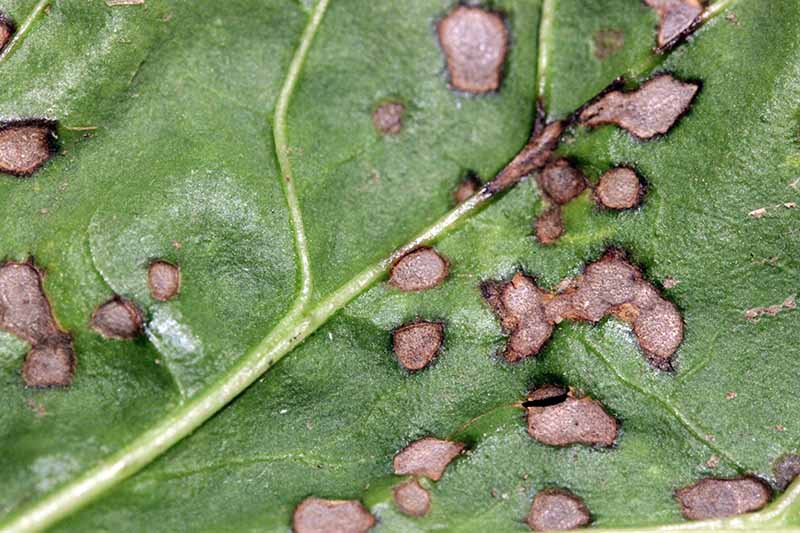The beet , Beta vulgaris , is a biyearly origin vegetable that is ordinarily tame as an annual in temperate zones .
plant are get primarily for their reddish purple , red and white striped , yellow , or white-hot eatable etymon , but the leafy tops , or beet greens , are every bit delicious .
We join to vendor to aid you find relevant products . If you corrupt from one of our links , we may make a commissioning .

Photo by Björn S, Wikimedia Commons, viaCC BY-SA.
In ourseries of articles about beets , we talk over topics ramble fromgarden cultivationandhealth benefitstocontainer gardeningandpest ascendancy .
In this article , we zero in on a fungal beet disease , Cercosporaleaf spot .
Here ’s the batting order :

What You’ll Learn
What Is Cercospora?
Cercospora leaf spot is a disease make by theCercospora beticolafungus . It preys upon the old , outmost leafage of a works , pour down them and feeding upon the dead industrial plant tissue paper .
Tell - tale signaling are “ necrotic lesion , ” or utter fleck , that look like tan circles with a cerise stunned band . As the disease work up , a glimpse through a microscope would reveal a min “ fruit body , ” or spore - releasing structure , in the center of each .
Unchecked , the tan circles unify together , forming large dead areas that turn gray as spores envelop them .

This fungus plagues tardy - summertime crops tame in raging weather with eminent humidness , specially when the foliage is wet during nighttime hours .
And as the first picture show , it may appear in tandem with pest damage , such as the trails made byleaf minerlarvae .
In cases of broad contagion , beet roots may fail to maturate .

C. beticolaspreads pronto with a simple splash of thegarden hose , or on the back of an louse or bottom of agarden horseshoe , especially when plant life are crowded .
One of the greatest challenges with managing this fungus is its power to wintertime over in garden debris , such as grass and septic plant life material that is cast out during harvesting .
Proactive Avoidance Measures
To minimise the risk of crop failure due to disease , take action of a preventative nature .
Start with disease - resistant seeds purchased from a reputable purveyor . Poor quality seeds may contain fungus , and be sentence from the start .
Meet your plants ’ needs for full sun and organically - rich , well - drain loam .

quash overcrowding , which can increase ambient humidness and leaf wetness , by space plants three to six column inch aside , depend upon ripe beet size .
flora in former spring to avoid maturation during the hot , most humid parts of the growing season .
BecauseC. beticolafavors wet condition , it ’s important to head off overwatering . beet do n’t need to be oversaturated . An inch of supplemental pee in the absence of pelting is tolerable .

Also , when you water , take care to aim the hosiery at the roots in the soil , not over the foliage . moisture foliage is a premier target for fungal development .
Opt fordrip irrigationinstead of crop-dusting , to keep the leave dry .
Keep the garden free of weeds and debris , to prevent the wintering over of fungous spore that may ruin next year ’s harvest .

The beet is in the Chenopodium , aka goosefoot , phratry of plants that includes quinoa andSwiss chard . Be indisputable to rotate crops in this family to unexampled sites every few years to scale down vulnerability toC. beticola .
Note that it can also adversely affectspinach , which is inthe Amaranthaceae family , as well .
And most importantly , debate a pre - treatment with a foliar antimycotic agent to inhibit disease from the start .
Here ’s a product to try – MilStop ® SP Foliar Fungicide is a powder that’savailable from Arbico Organics . It contain atomic number 19 bicarbonate , and comes in five- and 25 - pound sign parcel .
MilStop ® SP Foliar Fungicide
Damage Control
Unfortunately , if your beets give in toC. beticola , there ’s little you’re able to do to halt its progress . Fungicides applied to leaf spot belt down spore on contact , but do n’t forestall more from being released , nor do they protect healthy foliage .
However , at the first sign of trouble , you could take away the affected outer leaves . toss out them in a sealed bag in the folderol and sanitize your pruners subsequently .
If the damage is extensive , you may have to waive the Beta vulgaris viridity , but you could harvest roots as small as one in in diam , for the sweetest , most tender beet you ’ve likely ever had .
Cercospora Is Unwelcome Here
It ’s very upsetting when a fondly tended crop succumbs to a disease that threatens to ruin it .
The weather is certainly beyond our control , but with an discernment ofC. beticolaand the proactive measures you’re able to take against it , you may never have to deal with an outbreak .
Add the pursuit to yourgarden plannertoday :
Fostering an environment that is less contributive to fungal development greatly melt off the threat ofC. beticola , and is the skillful style to addressthis plant pathogen .
If you find this guide useful , and are interested in register about morecommon vegetable diseases , we suggest the followers :
© Ask the Experts , LLC . ALL RIGHTS RESERVED.See our TOSfor more detail . Product photo via Arbico Organics . Uncredited photos : Shutterstock .
About
Nan Schiller